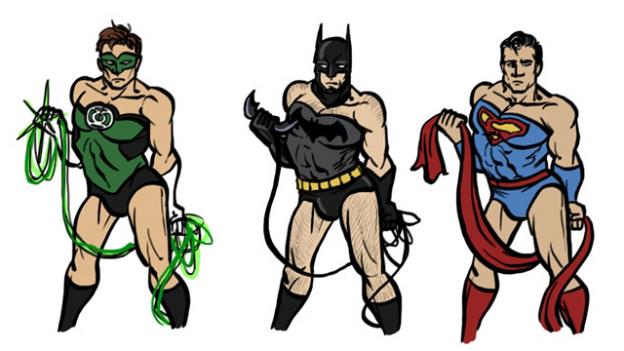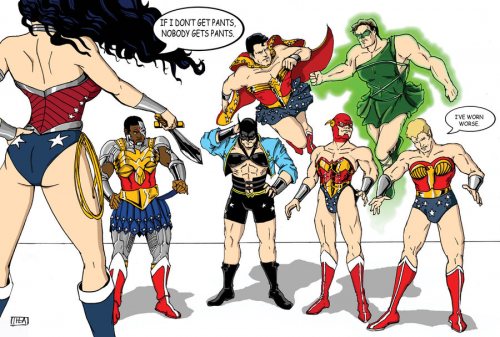Since Lino DaSilvo’s sexist comments about how female characters are hard to draw because they’ve got to be pretty, he’s had many defenders comment on how much this artist cares about his movies and characters.
No one is saying DaSilvo doesn’t care about his art. No one is even saying that “Frozen” isn’t a good movie. “Ratatouille” is a great movie, and it also follows the same sexist pattern of most children’s movies where females can’t be heroes. Unfortunately, this sexism is entrenched in our culture, the stories we tell, and the heroes we create. Abnoba makes a great comment about all this on Reel Girl:
And female characters are even more difficult to differentiate because, as he says, they have to be pretty. And pretty, for Disney and other companies, has a very narrow definition. I think that we all know how Disney tried to change Merida. Disney is not only selling a movie. The Disney princess are used to sell clothes, toys, party supplies, make up…and that’s not based in how adventurous or smart they are, their beauty is a big selling point…Maybe Lino DiSalvo is not sexist, maybe he is just too frank for his own good about what that industry require from him, but I think that the comment is pointing to a very big problem in the female representation of women in animation.
You can be frank and sexist at the same time. As I blogged, I don’t think DaSilvo intended to be sexist. He thought he was stating a fact. And he actually is, but the fact is not about real differences between females and males, but about how they are represented in narratives for children in 2013.
Here’s something I wrote a while ago on the differences between drawing females and males:
Whenever I blog about the exaggerated breasts or ass of a female cartoon character, commenters respond that I have nothing to complain about: all cartoons are caricatures.
There’s a difference between exaggerating muscles and exaggerating someone’s butt. Here’s artist Kevin Bolk’s take on “The Avengers.”
Of course, “The Avengers” model, with its pathetic 5: 1 male/ female ratio and then sexualizing that lone female, is not unique to that group of superheroes.
Check out the Justice League cover. Notice any similarity?
Here’s the artist Coelasquid’s “If Superheroes Posed Like Wonder Woman.”
I love Coelasquid’s art because it shows so clearly that it’s not only the clothes put on female characters but the poses they are in.
Though of course, the clothes don’t help much. Here’s Theamat’s “If I Don’t Get Pants, Nobody Gets Pants:”
Wonder Woman with no pants was created by (and for?) grown-ups but it leads to Wonder Woman with no pants showing up as a LEGO minifig.
Females are half of the population, yet because they are presented as a sexualized minority in so many movies for adults, they are also presented as a sexualized minority in movies for kids. Those roles are then replicated in kids’ toys and most tragically, in kids’ imaginary play.
Female characters account for only 16% of all characters in movies for kids.
Here’s an interesting coincidence: across the board in all professions, women at the top don’t make it past 16%.
Do you think limiting females in the imaginary world limits them in real life? Unfortunately, your kids do.







Disney released a statement on Thursday (that everyone has ignored, surprise suprise) regarding the comment. I agree 100%.
Here’s what they have to say:
“Animation is an intricate and complex art form. These comments were recklessly taken out of context. As part of a roundtable discussion, the animator was describing some technical aspects of CG animation and not making a general comment on animating females versus males or other characters.”
http://www.thewrap.com/disneys-frozen-animator-female-characters-really-really-difficult/
So my suspicions are confirmed. This is all controversy for the sake of controversy.
Could Lino have chosen his words more carefully since he’s being interviewed for a website where most of the readers have never animated before and don’t understand the terminology?
Yeah, probably.
Now I’ve learned, if you work for Disney, WATCH WHAT YOU SAY or you’ll be branded and eeevvvviiilll sexist pig if you say something that can even slightly be taken out of context.
Disney is an easy target for some good ‘ol fashioned “outrage” and fabricated controversy after all.
Hi Animator,
Thanks for this quote, I haven’t seen it and will post it on Reel Girl. To me, it seems like the same old non-apology-apology. Lino said girls need to be pretty and it’s difficult to make 2 look different. As many have commented, and many posts on Reel Girl refer to, male characters are allowed to exist in all kinds of shapes and sizes, literally and metaphorically; females are far more limited on screen and in real life.
Margot
Cool, looking forward to hearing your thoughts on that.
Now, taking a complete left turn, Joanna Quinn (an amazing British female animator) makes some pretty good points as well about animating *convincing* (rather then “pretty”) female characters (calling Lino’s comments “complete rubbish”):
http://www.cartoonbrew.com/ideas-commentary/joanna-quinn-says-disney-animators-comments-are-complete-rubbish-animating-women-with-emotions-is-easy-89627.html
Here’s her website, I think you’ll enjoy her work:
http://www.berylproductions.co.uk/
Like I said, I don’t think Lino’s comments are (intentionally at least) sexist, but I admit he could have chosen his words more carefully for sure.
Wow. Honestly?? I love how you complain about this of all things. I could argue that for the Avengers poster they have some of the male hero’s crotches in plain sight, so why are you upset over a butt?
Also, the LEGOs.. Yeaaaa.. The last FULLY clothed character on the far right.. HER name is Harley Quinn… And notice how SHE isn’t half naked? Sure some are, but not all so chill.
Feminism isn’t so that you can complain about body parts being blown out of proportions, its so females have equal rights. Quit being such a spoiled baby about every little thing.
(I would apologize for my rudeness, but I am thoroughly upset.)
Hi Desi,
Are we looking at the same picture because I’m missing the bulging crotches. As far as Harley Quinn, your point is not all of the females are pantless, “sure some are, but not all so chill”? Feminism is about women and men having political, social, and economic equality, something that will never happen has long as females are valued for how they appear while males are valued for what they do.
Margot
If you are saying that there is not a problem with sexualization of women in comics, Harley Quinn is not the best argument. I’d say that she is a perfect example of the problem.
The LEGO minifig wears her original suit, but that is no her current suit. Harley Quinn was created for Batman: The Animated Series and later incorporated to the official Batman canon. I doubt that the series creator would think that a sexy outfit was appropriate in a show for kids. But take a look at the changes in the videogame and in the reboot of the DC universe
http://geekdom.hubpages.com/hub/Harley-Quinn-Costume-History
Besides Namor and Ka-zar, how many other male heros have something even similar. ¿Something like Power girl’s boob window?
http://hubpages.com/hub/Power-Girl-Costume-History
¿Like Black Canary and Zatanna fishnets?
http://hubpages.com/hub/Black-Canary-Costume-History
http://hubpages.com/hub/Zatanna-Costume-History
¿Like Psylocke ninja suit?
http://geekdom.hubpages.com/hub/Psylocke-Costume-History
Marvel even changed Kirby’s design for Hela
http://www.marveldirectory.com/individuals/h/hela.htm
so she coud display cleavage better
http://marvel.com/universe/Hela
because that is just what the Queen of Hel needs.
¿How many male characters fight in high heels?
Yes, not all the designs are bad and before the 90’s the sexualization was not so excessive. But nowadays, is common enough that is easier to count the series where the heroines are NOT sexualized
Wait, everything has to be wrong before we can point out that something is wrong?
Feminism is precisely so that I can complain about beauty standards that mean that 6 year olds start pining to be sexy, ten year olds hate their bodies, people congratulate toddler girls on being pretty, girls aspire to be models, and body loathing haunts women throughout their lives.